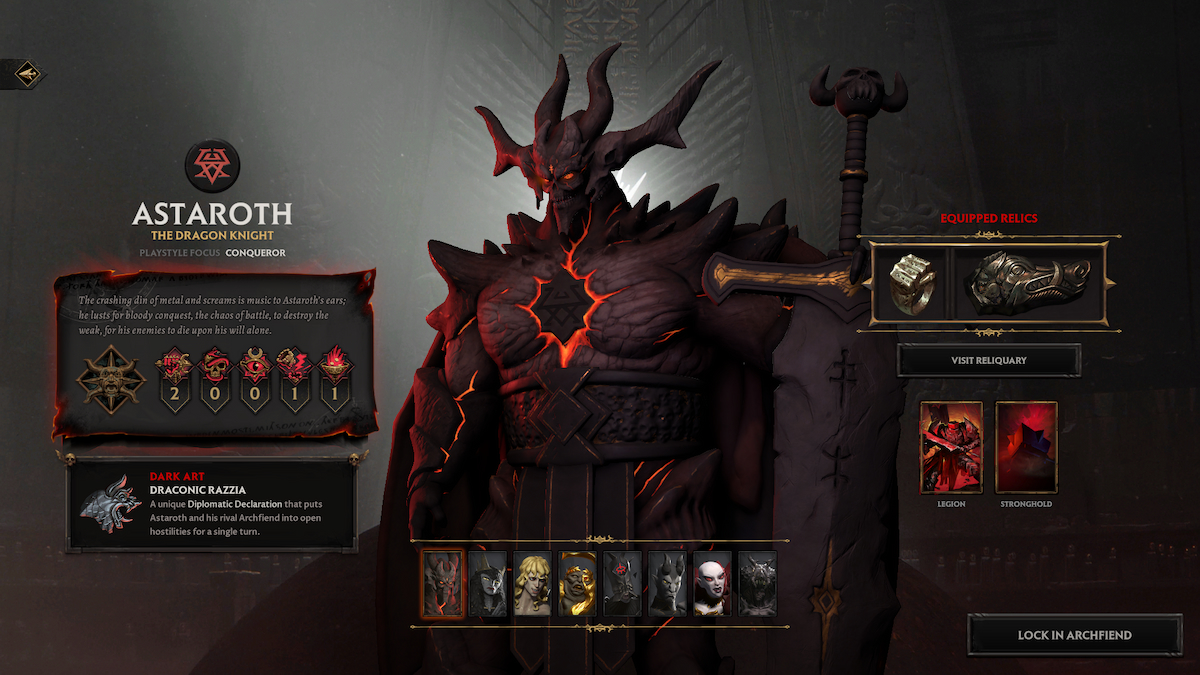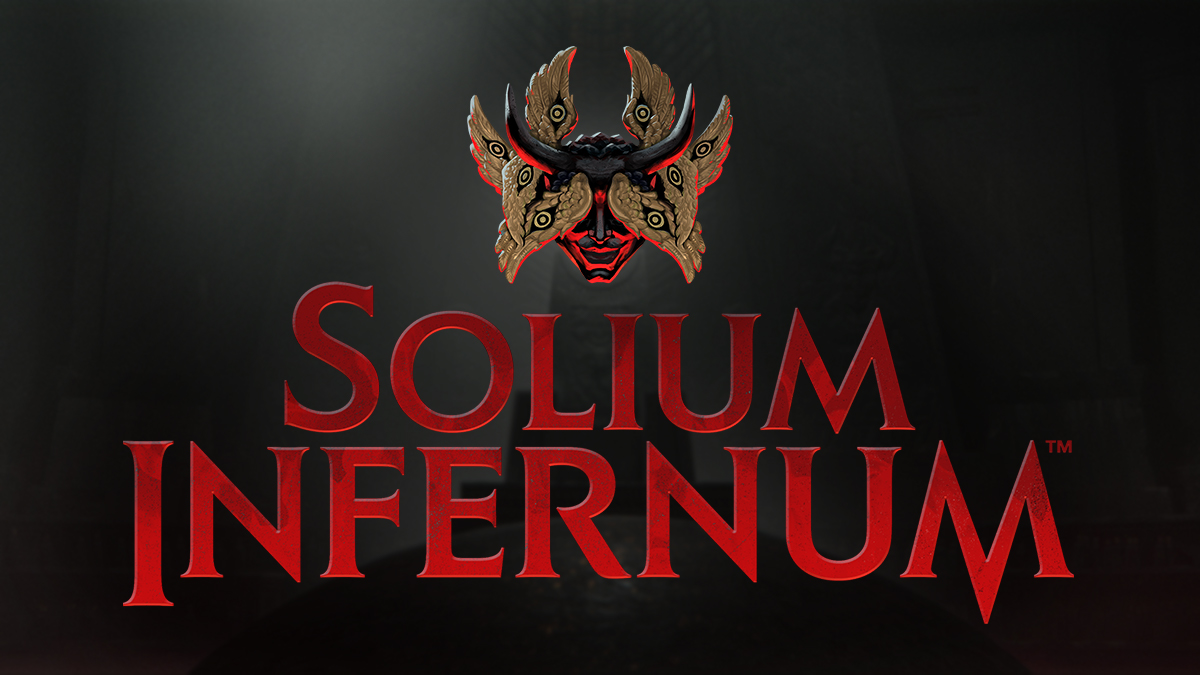Solium Infernum is unlike any strategy game I have ever played.
This reimagining of a cult classic strategy game is something truly unique in the genre, with its focus on deceitful political games, outwitting and out-maneuvering opponents, and the backdrop of hell without a king, it offers up a truly unique experience no other strategy game has done for me in a long time. It’s got choice, consequence, and a lot of demons, and it’s a blast to play.
Key Details
- Developer: League of Geeks
- Platforms: PC (Steam)
- Release Date: February 22, 2024
- Price: $39.99
Fiendish Fun and a Little Backstabbing

League of Geeks’ previous game, Armello, saw a developer create a new, fresh board game-style RPG with tactics, careful planning, and some moments of wickedness thrown in to mess with other players. For Solium Infernum, these ideas and design choices have been turned up to 11, especially that wickedness part, and it makes for a strategic and unique board game style game unlike any I’ve played before.
The premise for this hellishly good experience is simple: the Prince of Darkness has vanished from hell and left the Infernal Throne vacant and up for the taking. Now, it’s up to you to outwit and outplay your opponents, take the throne for yourself, and claim dominion over hell as its new ruler. To claim the throne, you’ll first need to take on the form of one of the game’s eight Archfiends, powerful beings who each possess different powers and lean towards various styles of gameplay including sorcery, conflict, and the art of diplomacy, all of which offer some distinct gameplay advantages and nuances.
Along with their abilities, you command legions of troops, use magic, and talk your way through situations in this ash-covered version of hell in synchronous turns, with the order determined by a Regent that changes with each turn. As you do so, you’ll grow in power, unlock new powers, and earn the ever-important Prestige, the primary resource and method by which you claim victory.

The simplest and often most used way of accumulating Prestige is through conquest, capturing the Places of Power, the rather intricate art of diplomacy, and wagers to gain as much as possible before the turn limit is reached. In truth, nearly every action has some way to earn, wager, or lose Prestige, and it’s often the crux of every weighty decision you’ll need to make during a match, and there are a lot of choices to make in this game.
Outside of that, you can crush the other Archfiends in battle or claim Pandemonium, the capital of hell. However, these are more laborious tasks, making pursuing them difficult since they often are far less effective options. If you decide to try that, have a go at it. The game invites a challenge, whether to your friendships or strategic mind.
This will take place in games that can be instant, intense matches that last for a few hours or across days and weeks, thanks to asynchronous multiplayer. Should you choose to play this way, games can be played for a few minutes a day, while the rest of your time can be spent scheming or pondering how your plans will play out or what your opponents are doing. Besides being an interesting way to play the game, it is also an excellent addition for players with less time to play. It invites a different kind of experience than your typical strategy or board game, be that physical or digital.

Add to this a single-player mode, Chronicles, which offers up narrative-driven challenges to complete, and you have quite the foundation for a great entry into the genre.
All of this combines into a good base that shows Leagues of Geeks’ pension for board game design and is only built upon and made all the better by the numerous other mechanics at work, and they are equally well implemented and much more sadistic.
A Game With A Hell-thy Amount of Choice

Beyond its core gameplay and ideas, Solium Infernum is filled with nuanced and layered mechanics and ideas that serve a simple goal: To make decisions that matter, are weighty, and sometimes a little stressful.
That starts with how you plan each of your turns. Each player begins a match with two order slots, which allow you to take your actions each turn, with the chance to earn more during the game. The order your actions take is also important, as they play out one by one in the order you choose, and depending on how you use them, can make a big difference to how your strategy plays out, like the amount of Tribute you earn, how you deal with combat, or any other aspect of the game. It’s an important factor in your tactics and the first of many.
Archfiends are another of these important choices. Aside from being aesthetically pleasing, Archfiends all feature a unique ability called a Dark Art, a special move that can be used to disrupt, summon, hinder, or buff legions, as well as a unique starting legion and different starting stats in the five powers: Wrath, Deceit, Prophecy, Destruction, and Charisma. Each of these opens up different gameplay options and can be leveled up during a match to help refine your style as you play. Depending on your Archfiend, you lean towards specific play styles, like sorcerers such as Murmur and Lilith, who start with penance for spells, or Astaroth, who is more about aggressive, combat-centric tactics. Archfiends also come equipped with your selection and combination of rings, amulets, and crowns, all of which grant additional buffs or effects to further tailor your playstyle, with each type taking up one or more of your three slots, making what you choose just as important as who.

From there, it’s into the thick of the game where you begin to make the real tough choices.
These decisions and mechanics are best summarised by separating them into two areas: Diplomacy and Conflict. These connect, intertwine, and play off each other beautifully during sessions but are equally their own beast to contend with and use how you choose.
For starters, let’s dip into the hellish bureaucracy that is rife in hell. Diplomacy has been rightly touted as one of the game’s key features, and it’s evident once you get into the game and see it play out for yourself. Much like politics in the real world, most of the options you have when it comes to diplomacy involve belittling and manipulating your opponents with several options. These are to demand, insult, declare, and propose other Archfiends into submitting to you, handing over resources, or getting into a fight, and all have their uses and benefits. Prestige is often your bargaining chip, and whether you aim to discredit, insult, or extort your opponent, you’ll often need to front some of your prestige in the process.
Once you have declared your action, it’s up to the recipient to decide how to react, and from there, several scenarios can play out. Should they accept and take the deformation and demand, they will hand over their resources, your wagered Prestige is returned, and you’ll have to wait three turns before making another diplomatic action against that player. If they don’t, they take your wagered Prestige but now open themselves up to repercussions.

But that’s the more violent side of the diplomatic discussions. It is also possible to propose temporary alliances and more permanent shows of solidarity thanks to emissaries and truces, which can help buy you time, win favor, and eventually persuade others to become your lieutenants and you, their Blood Lord. This sees your new lieutenant hand over all their Prestige at the end of a game, hoping their contributions will help you secure the win and claim some of the glory alongside you.
Then you get Edicts, moments where you’ll need to vote for outcomes that can benefit or annoy you and other players, giving you another opportunity to mess with the game and shift the balance. Lastly, you have Plots, which are randomly generated objectives that provide additional ways to earn Prestige, with the option to do public or private ones, with different consequences and the potential to sow doubt, frustration, and conflict further.
That’s the talking, manipulative side of the coin. The other is much more violent and focused on conquest and conflict, which can be just as rewarding and stressful at times.
When Words Fail

When your words fail, it often comes down to violence to resolve your issues with your other players, and this often takes on the form of Vendettas.
Vendettas are your method of going to battle with other Archfiends and once again involve wagering Prestige against a set of conditions that you set against the affected player. This can be to capture their territories, called Cantons, take their Places of Power, or defeat a number of their legions in a set amount of turns. It’s then down to you to complete that task, win the Vendetta, get your Prestige reward, and revert to being unable to attack and claim enemy Cantons until another Vendetta. Eventually, this can escalate into a Blood Feud, a constant war between the two Archfiends, and ultimately result in one’s destruction.
Here is where Tributes, Legions, and a host more fiendish features come into play.
Tributes are second to your Prestige when it comes to currencies, as these will be spent and used just as much, only for more violent means. Four Tribute types can be earned through a select action on your turn or through negotiation, extortion, and some more magical means. You’ll be using them to purchase nearly every army and item in the game.

As for what you can purchase, that is a rather robust offering, much like the game’s political system. For starters, you have Legions, your armies that march across hell and capture land and Places of Power. They also slaughter your enemies through combat, which plays out through a ranged, melee, and infernal stage. If you have more damage in these stats and reduce an enemy Legion to zero, you defeat the Legion, gain experience, and promote them to unlock more power and damage. They also come with perks and abilities that further add to their strategic offerings and potential, only amplified by the other elements of conflict.
Beyond their inherent abilities, Legions can be empowered in multiple ways, adding to the depth and decisions the game is already overflowing with. You have Praetors, a powerful leader-like unit you attach to your Legions to provide new perks or make stronger or to use in Praetor Duels, should prefer to refrain from indulging in a full-blown Vendetta with a foe. Artifacts are your items, which, when equipped to Legions, add more to their damage, give new abilities, or provide additional perks to make them better killing machines. Then you have Manuscripts, which improve Legions with more movement and other bonuses and provide other benefits like improving some Archfiend-centric mechanics.
But that’s not all; we also have more layers to this intricate web of systems, including Rituals, which allows you to cast spells to weaken enemies, buff Legions, steal, mess with, and generally affect that game in some way.

Now, it does have the sometimes unpleasant effect of feeling more like work or tipping a little too much into the stressful territory. I had a few moments during my time with the game where I felt lost or suffered from choice paralysis, and the game does give you so much to work with, so it can be daunting. That’s not to say it is bad; the idea of more options in gameplay is undoubtedly more appealing than less, but it is on a razor’s edge at times between being a bit too stressful that might be off-putting for some.
The game is designed for your to screw over your opponents, form bonds, break them, and let your sadistic side out. Everything the game offers you in terms of choice is geared towards those ideals and does so to great effect, even if, on occasion, it dips into being a little too open. Its choices are meaningful and impactful, and with all the layers to how you can play a match, it makes for a great mix of social deduction, manipulation, and witty strategies that I see being fun for a long time.
An Infernal Feast For Your Eyes

For all the great gameplay I’ve been harping on about, I want to say how much I love the game’s style and aesthetic. Inspired by the epic poem Paradise Lost, this version of hell is muted and greyscale in appearance, yet it still splashes in pieces of color and detail, making it somewhat minimal but with impactful accents.
Character design is equally stellar, sporting that slight cartoon-ish style seen from Armello, only here with the hellish twist of these Archfiends, all distinct and brought to life with great detail and feel and look the part in this version of hell. Legions fare less well in that sense and are rather basic in appearance, though this was my only real gripe with the game’s visuals. As for UI, it sports a dark, stone-like texture, plenty of detail, and hues of red and gold, and for lack of a better term, it looks really moody and cool.

What steals the show is the artwork that you’ll see on all the game screens and throughout the game. Nearly every item in the game, from Ritual Card, Manuscripts, to Legion portraits, is accompanied by stunning artwork that’s equal parts dark and grotesquely beautiful. These include the hellish creatures and soldiers of hell, the Praetors, Artifacts, and items, all of which sport amazingly detailed illustrations full of color and style that are truly a feast for the eyes. I’d often take a moment just to admire them, and they are, without a doubt, some of the best visuals and artwork I’ve seen in a game for a long time. So, aside from the game playing well, it looks pretty great too.
Verdict

I’ll end this review by reinforcing what I said from the start: Solium Infernum is unlike any strategy game I have ever played. At times, it felt brutal, and at others, delightful and wicked, but it always felt like what I was doing was important and impacted the game. Its choices are weighty, your actions have consequences, and the way it makes you tip into your dark side for fun is something I truly enjoyed. Every game and action I knew would be intense and exciting, and all its layers came together nicely to deliver a truly unique experience.
Yes, sometimes it gets a little stressful and can be a bit tedious at times, but that stress was worth the throne.
Final Score:
8 / 10
| + Artwork is top-notch and stunning | |
| + Gameplay is layered and loaded with choices | |
| + Choices matter and feel impactful | |
| – Can become a little tedious and stressful at times |
The Gamepur team received a PC code for the purpose of this review.






